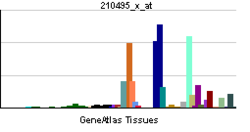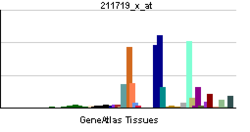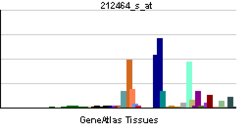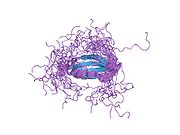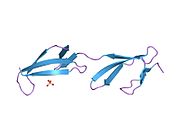- Fibronectin
-
Fibronectin is a high-molecular weight (~440kDa) glycoprotein of the extracellular matrix that binds to membrane-spanning receptor proteins called integrins.[1] In addition to integrins, fibronectin also binds extracellular matrix components such as collagen, fibrin and heparan sulfate proteoglycans (e.g. syndecans).
Fibronectin exists as a protein dimer, consisting of two nearly identical monomers linked by a pair of disulfide bonds.[1] The fibronectin protein is produced from a single gene, but alternative splicing of its pre-mRNA leads to the creation of several isoforms.
Two types of fibronectin are present in vertebrates:[1]
- soluble plasma fibronectin (formerly called "cold-insoluble globulin", or CIg) is a major protein component of blood plasma (300 μg/ml) and is produced in the liver by hepatocytes.
- insoluble cellular fibronectin is a major component of the extracellular matrix. It is secreted by various cells, primarily fibroblasts, as a soluble protein dimer and is then assembled into an insoluble matrix in a complex cell-mediated process.
Fibronectin plays a major role in cell adhesion, growth, migration and differentiation, and it is important for processes such as wound healing and embryonic development.[1] Altered fibronectin expression, degradation, and organization has been associated with a number of pathologies, including cancer and fibrosis.[2]
Contents
Structure
Fibronectin exists as a protein dimer, consisting of two nearly identical polypeptide chains linked by a pair of C-terminal disulfide bonds.[3] Each fibronectin monomer has a molecular weight of 230–250 kDa and contains three types of modules: type I, II, and III. All three modules are composed of two anti-parallel β-sheets; however, type I and type II are stabilized by intra-chain disulfide bonds, while type III modules do not contain any disulfide bonds. The absence of disulfide bonds in type III modules allows them to partially unfold under applied force.[4]
Three regions of variable splicing occur along the length of the fibronectin protomer. One or both of the "extra" type III modules (EIIIA and EIIIB) may be present in cellulafibronectin, but they are never present in plasma fibronectin. A "variable" V-region exists between III14–15 (the 14th and 15th type III module). The V-region structure is different from the type I, II, and III modules, and its presence and length may vary. The V-region contains the binding site for α4β1 integrins. It is present in most cellular fibronectin, but only one of the two subunits in a plasma fibronectin dimer contains a V-region sequence.
The modules are arranged into several functional and protein-binding domains along the length of a fibronectin monomer. There are four fibronectin-binding domains, allowing fibronectin to associate with other fibronectin molecules.[3] One of these fibronectin-binding domains, I1–5, is referred to as the "assembly domain", and it is required for the initiation of fibronectin matrix assembly. Modules III9–10 correspond to the "cell-binding domain" of fibronectin. The RGD sequence (Arg–Gly–Asp) is located in III10 and is the site of cell attachment via α5β1 and αVβ3 integrins on the cell surface. The "synergy site" is in III9 and has a role in modulating fibronectin's accociation with α5β1 integrins.[5] Fibronectin also contains domains for fibrin-binding (I1–5, I10–12), collagen-binding (I6–9), fibulin-1-binding (III13–14), heparin-binding and syndecan-binding (III12–14).[3]
Function
Fibronectin has numerous functions that ensure the normal functioning of vertebrate organisms.[1] It is involved in cell adhesion, growth, migration and differentiation. Cellular fibronectin is assembled into the extracellular matrix, an insoluble network that separates and supports the organs and tissues of an organism.
Fibronectin plays a crucial role in wound healing.[6][7] Along with fibrin, plasma fibronectin is deposited at the site of injury, forming a blood clot that stops bleeding and protects the underlying tissue. As repair of the injured tissue continues, fibroblasts and macrophages begin to remodel the area, degrading the proteins that form the provisional blood clot matrix and replacing them with a matrix that more resembles the normal, surrounding tissue. Fibroblasts secrete proteases, including matrix metalloproteinases, that digest the plasma fibronectin, and then the fibroblasts secrete cellular fibronectin and assemble it into an insoluble matrix. Fragmentation of fibronectin by proteases has been suggested to promote wound contraction, a critical step in wound healing. Fragmenting fibronectin further exposes its V-region, which contains the site for α4β1 integrin-binding. These fragments of fibronectin are believed to enhance α4β1 integrins-expressing cell binding, allowing them to adhere to and forcefully contract the surrounding matrix.
Fibronectin is necessary for embryogenesis, and inactivating the gene for fibronectin results in early embryonic lethality.[8] Fibronectin is important for guiding cell attachment and migration during embryonic development. In mammalian development, the absence of fibronectin leads to defects in mesodermal, neural tube, and vascular development. Similarly, the absence of a normal fibronectin matrix in developing amphibians causes defects in mesodermal patterning and inhibits gastrulation.[9]
Fibronectin is also found in normal human saliva, which helps prevent colonization of the oral cavity and pharynx by potentially pathogenic bacteria.[10]
Matrix assembly
Cellular fibronectin is assembled into an insoluble fibrillar matrix in a complex cell-mediated process.[11] Fibronectin matrix assembly begins when soluble, compact fibronectin dimers are secreted from cells, often fibroblasts. These soluble dimers bind to α5β1 integrin receptors on the cell surface and aide in clustering the integrins. The local concentration of integrin-bound fibronectin increases, allowing bound fibronectin molecules to more readily interact with one another. Short fibronectin fibrils then begin to form between adjacent cells. As matrix assembly proceeds, the soluble fibrils are converted into larger insoluble fibrils that comprise the extracellular matrix.
Fibronectin’s shift from soluble to insoluble fibrils proceeds when cryptic fibronectin-binding sites are exposed along the length of a bound fibronectin molecules. Cells are believed to stretch fibronectin by pulling on their fibronectin-bound integrin receptors. This force partially unfolds the fibronectin ligand, unmasking cryptic fibronectin-binding sites and allowing nearby fibronectin molecules to associate. This fibronectin-fibronectin interaction enables the soluble, cell-associated fibrils to branch and stabilize into an insoluble fibronectin matrix.
Role in cancer
Several of the morphological changes observed in tumors and tumor-derived cell lines have been attributed to decreased fibronectin expression, increased fibronectin degradation, and/or decreased expression of fibronectin-binding receptors, such as α5β1 integrins.[12]
Fibronectin has been implicated in carcinoma development.[13] In lung carcinoma, fibronectin expression is increased, especially in non-small cell lung carcinoma. The adhesion of lung carcinoma cells to fibronectin enhances tumorigenicity and confers resistance to apoptosis-inducing chemotherapeutic agents. Fibronectin has been shown to stimulate the gonadal steroids that interact with vertebrate androgen receptors, which are capable of controlling the expression of cyclin D and related genes involved in cell cycle control. These observations suggest that fibronectin may promote lung tumor growth/survival and resistance to therapy, and it could represent a novel target for the development of new anticancer drugs.
Fibronectin 1 acts as a potential biomarker for radioresistance.[14]
Role in wound healing
Fibronectin has profound effects on wound healing, including the formation of proper substratum for migration and growth of cells during the development and organization of granulation tissue as well as remodeling and resynthesis of the connective tissue matrix.[15] The biological significance of fibronectin in invivo was studied during the mechanism of wound healing.[15] Plasma fibronectin levels are decreased in acute inflammation or following surgical trauma and in patients with intravascular disseminated coagulation.[16]
Fibronectin is located predominantly in the basement membranes of the adult tissues, but may be more widely distributed in inflammatory lesions. During clotting of the plasma the fibronectin remains associated with the clot, covalently cross linked to the fibrin with the help of factor XIII (fibrin stabilizing factor).[17][18] Fibroblasts play a major role in wound healing by adhering to fibrin. The adhesion of fibroblast to the fibrin requires the presence of fibronectin and it was maximum when the fibronectin is crossslinked to the fibrin. Patients with factor XIII deficiencies display impairment in wound healing and also that the fibroblasts don’t grow in the fibrin which is deficient in this factor. Fibronectin promotes phagocytosis of the particles not only by the macrophages but also by the fibroblasts. The deposition of collagen in the wounded site by the fibroblasts takes place with the help of fibronectin. Fibronectin was also observed to be closely associated with the newly deposited collagen fibrils. Based on the size and histological staining chatracteristics of the fibrils it is likely that atleast in part they are composed of type III collagen (reticulin). The invitro study with the native collagen has demonstrated that the fibronectin binds to type III collagen rather than to any other types.[19]
In vivo vs in vitro
Plasma fibronectin, which is synthesized by hepatocytes,[20] and fibronectin synthesized by cultured fibroblasts are similar but not identical; immunological, structural, and functional differences have been reported.[21] It is likely that these differences result from differential processing of a single nascent mRNA. Nevertheless, plasma fibronectin can be insolubilized into the tissue extracellular matrix in vitro and in vivo. Both plasma and cellular fibronectins in the matrix form high molecular weight, disulfide-bonded multimers. The mechanism of formation of these multimers is not known. Plasma fibronectin has been shown to contain two free sulfhydryls per subunit (X), and cellular fibronectin has been shown to contain at least one. These sulfhydryls probably are buried within the tertiary structure, because sulfhydryls are exposed when the fibronectin is denatured. Such denaturation results in the oxidation of free sulfhydryls and formation of disulfide-bonded fibronectin multimers. This has led to speculation that the free sulfhydryls may be involved in formation of disulfide-bonded fibronectin multimers in the extracellular matrix. Consistent with this, sulfhydryl modification of fibronectin with N-ethylmaleimide prevents binding to cell layers. Tryptic cleavage patterns of multimeric fibronectin do not reveal the disulfide-bonded fragments that would be expected if multimerization involved one or both of the free sulfhydryls. The free sulfhydryls of fibronectin are not required for the binding of fibronectin to the cell layer or for its subsequent incorporation into the extracellular matrix. Disulfide-bonded multimerization of fibronectin in the cell layer occurs by disulfide bond exchange in the disulfide-rich amino-terminal one-third of the molecule.[21]
Interactions
Besides integrin, fibronectin binds to many other host and non-host proteins. For example, it has been shown to interact with fibrin, heparin, tenascin, TNF-α, BMP-1, rotavirus NSP-4, and many fibronectin binding proteins from bacteria like FBP-A, FBP-B on the N-terminal domain.
Fibronectin has been shown to interact with:
See also
- Fetal fibronectin
- Fibronectin type I domain
- Fibronectin type II domain
- Fibronectin type III domain
- Monobody, an engineered antibody mimetic based on the structure of the fibronectin type III domain
- Substrate adhesion molecules
References
- ^ a b c d e Pankov R, Yamada KM (October 2002). "Fibronectin at a glance". Journal of cell science 115 (Pt 20): 3861–3. doi:10.1242/jcs.00059. PMID 12244123.
- ^ Williams CM, Engler AJ, Slone RD, Galante LL, Schwarzbauer JE (May 2008). "Fibronectin expression modulates mammary epithelial cell proliferation during acinar differentiation". Cancer research 68 (9): 3185–92. doi:10.1158/0008-5472.CAN-07-2673. PMC 2748963. PMID 18451144. http://www.pubmedcentral.nih.gov/articlerender.fcgi?tool=pmcentrez&artid=2748963.
- ^ a b c Mao Y, Schwarzbauer JE (September 2005). "Fibronectin fibrillogenesis, a cell-mediated matrix assembly process". Matrix biology : journal of the International Society for Matrix Biology 24 (6): 389–99. doi:10.1016/j.matbio.2005.06.008. PMID 16061370.
- ^ Erickson HP (2002). "Stretching fibronectin". Journal of muscle research and cell motility 23 (5–6): 575–80. doi:10.1023/A:1023427026818. PMID 12785106.
- ^ Sechler JL, Corbett SA, Schwarzbauer JE (December 1997). "Modulatory roles for integrin activation and the synergy site of fibronectin during matrix assembly". Molecular biology of the cell 8 (12): 2563–73. PMC 25728. PMID 9398676. http://www.molbiolcell.org/cgi/content/abstract/8/12/2563.
- ^ Grinnell F (1984). "Fibronectin and wound healing". J. Cell Biochem 26 (2): 107–116. doi:10.1002/jcb.240260206. PMID 6084665.
- ^ Valenick LV, Hsia HC, Schwarzbauer JE (September 2005). "Fibronectin fragmentation promotes alpha4beta1 integrin-mediated contraction of a fibrin-fibronectin provisional matrix". Experimental cell research 309 (1): 48–55. doi:10.1016/j.yexcr.2005.05.024. PMID 15992798.
- ^ George EL, Georges-Labouesse EN, Patel-King RS, Rayburn H, Hynes RO (December 1993). "Defects in mesoderm, neural tube and vascular development in mouse embryos lacking fibronectin". Development (Cambridge, England) 119 (4): 1079–91. PMID 8306876. http://dev.biologists.org/cgi/content/abstract/119/4/1079.
- ^ Darribère T, Schwarzbauer JE (April 2000). "Fibronectin matrix composition and organization can regulate cell migration during amphibian development". Mechanisms of development 92 (2): 239–50. doi:10.1016/S0925-4773(00)00245-8. PMID 10727862.
- ^ Hasty DL, Simpson WA (September 1987). "Effects of fibronectin and other salivary macromolecules on the adherence of Escherichia coli to buccal epithelial cells". Infection and immunity 55 (9): 2103–9. PMC 260663. PMID 3305363. http://iai.asm.org/cgi/content/abstract/55/9/2103.
- ^ Wierzbicka-Patynowski I, Schwarzbauer JE (August 2003). "The ins and outs of fibronectin matrix assembly". Journal of cell science 116 (Pt 16): 3269–76. doi:10.1242/jcs.00670. PMID 12857786.
- ^ Hynes, Richard O. (1990). Fibronectins. Berlin: Springer-Verlag. ISBN 0-387-97050-9.
- ^ Han S, Khuri FR, Roman J (January 2006). "Fibronectin stimulates non-small cell lung carcinoma cell growth through activation of Akt/mammalian target of rapamycin/S6 kinase and inactivation of LKB1/AMP-activated protein kinase signal pathways". Cancer research 66 (1): 315–23. doi:10.1158/0008-5472.CAN-05-2367. PMID 16397245.
- ^ Jerhammar F, Ceder R, Garvin S, Grénman R, Grafström RC, Roberg K. (January 2011). "Fibronectin 1 is a potential biomarker for radioresistance in head and neck squamous cell carcinoma.". Cancer Biology and Therapy 10 (12): 1244–1251. PMID 20930522.
- ^ a b Grinnell F, Billingham RE, Burgess L. (1981). "Distribution of fibronectin during wound healing in vivo". The Journal of Investigative Dermatology 76 (3): 181–189. doi:10.1111/1523-1747.ep12525694. PMID 7240787.
- ^ Bruhn HD, Heimburger N. (1976). "Factor VIII- related antigen and cold-insoluble globulin in leukimeias and carcinomas". Haemostasis 5 (3): 189–192. PMID 1002003.
- ^ Mosher DF. (August 1975). "Cross linking of cold insoluble globulin by fibrin stabilizing factor". The Journal of Biological Chemistry 250 (16): 6614–6621. PMID 1158872.
- ^ Mosher DF. (March 1976). "Action of fibrin-stabilising factor on cold-insoluble fibroectin and alpha2-macroglobulin in clotting plasma". The Journal of Biological Chemistry 251 (6): 1639–1645. PMID 56335.
- ^ Engvall E, Ruoslahti E, Miller E J. (April 1978). "Affinity of fibronecti n to collagens of different genetic types and to fibrinogen". The Journal of Experimental Medicine 147 (6): 1584–1595. doi:10.1084/jem.147.6.1584. PMID 567240.
- ^ Tamkun JW, Hynes RO (April 1983). "Plasma fibronectin is synthesized and secreted by hepatocytes". J. Biol. Chem. 258 (7): 4641–7. PMID 6339502.
- ^ a b Paula J. McKeown-LongoS and Deane F. Mosherg (october 2010). "Mechanism of Formation of Disulfide-bonded Multimers of Plasma Fibronectin in Cell Layers of Cultured Human Fibroblasts". journal of Biological Chemistry 259 (19): 12210–12215. PMID 6480605.
- ^ Jalkanen S, Jalkanen M (February 1992). "Lymphocyte CD44 binds the COOH-terminal heparin-binding domain of fibronectin". J. Cell Biol. 116 (3): 817–25. doi:10.1083/jcb.116.3.817. PMC 2289325. PMID 1730778. http://www.pubmedcentral.nih.gov/articlerender.fcgi?tool=pmcentrez&artid=2289325.
- ^ Lapiere JC, Chen JD, Iwasaki T, Hu L, Uitto J, Woodley DT (November 1994). "Type VII collagen specifically binds fibronectin via a unique subdomain within the collagenous triple helix". J. Invest. Dermatol. 103 (5): 637–41. doi:10.1111/1523-1747.ep12398270. PMID 7963647.
- ^ Chen M, Marinkovich MP, Veis A, Cai X, Rao CN, O'Toole EA, Woodley DT (June 1997). "Interactions of the amino-terminal noncollagenous (NC1) domain of type VII collagen with extracellular matrix components. A potential role in epidermal-dermal adherence in human skin". J. Biol. Chem. 272 (23): 14516–22. doi:10.1074/jbc.272.23.14516. PMID 9169408.
- ^ Salonen EM, Jauhiainen M, Zardi L, Vaheri A, Ehnholm C (December 1989). "Lipoprotein(a) binds to fibronectin and has serine proteinase activity capable of cleaving it". EMBO J. 8 (13): 4035–40. PMC 401578. PMID 2531657. http://www.pubmedcentral.nih.gov/articlerender.fcgi?tool=pmcentrez&artid=401578.
- ^ Martin JA, Miller BA, Scherb MB, Lembke LA, Buckwalter JA (July 2002). "Co-localization of insulin-like growth factor binding protein 3 and fibronectin in human articular cartilage". Osteoarthr. Cartil. 10 (7): 556–63. doi:10.1053/joca.2002.0791. PMID 12127836.
- ^ Gui Y, Murphy LJ (May 2001). "Insulin-like growth factor (IGF)-binding protein-3 (IGFBP-3) binds to fibronectin (FN): demonstration of IGF-I/IGFBP-3/fn ternary complexes in human plasma". J. Clin. Endocrinol. Metab. 86 (5): 2104–10. doi:10.1210/jc.86.5.2104. PMID 11344214.
- ^ Chung CY, Zardi L, Erickson HP (December 1995). "Binding of tenascin-C to soluble fibronectin and matrix fibrils". J. Biol. Chem. 270 (48): 29012–7. doi:10.1074/jbc.270.48.29012. PMID 7499434.
- ^ Zhou Y, Li L, Liu Q, Xing G, Kuai X, Sun J, Yin X, Wang J, Zhang L, He F (May 2008). "E3 ubiquitin ligase SIAH1 mediates ubiquitination and degradation of TRB3". Cell. Signal. 20 (5): 942–8. doi:10.1016/j.cellsig.2008.01.010. PMID 18276110.
Further reading
- ffrench-Constant C (1996). "Alternative splicing of fibronectin—many different proteins but few different functions.". Exp. Cell Res. 221 (2): 261–71. doi:10.1006/excr.1995.1374. PMID 7493623.
- Snásel J, Pichová I (1997). "The cleavage of host cell proteins by HIV-1 protease.". Folia Biol. (Praha) 42 (5): 227–30. doi:10.1007/BF02818986. PMID 8997639.
- Schor SL, Schor AM (2003). "Phenotypic and genetic alterations in mammary stroma: implications for tumour progression.". Breast Cancer Res. 3 (6): 373–9. doi:10.1186/bcr325. PMC 138703. PMID 11737888. http://www.pubmedcentral.nih.gov/articlerender.fcgi?tool=pmcentrez&artid=138703.
- Przybysz M, Katnik-Prastowska I (2002). "[Multifunction of fibronectin] [Multifunction of fibronectin]" (in Polish). Postȩpy higieny i medycyny doświadczalnej 55 (5): 699–713. PMID 11795204.
- Rameshwar P, Oh HS, Yook C et al. (2003). "Substance p-fibronectin-cytokine interactions in myeloproliferative disorders with bone marrow fibrosis". Acta Haematol. 109 (1): 1–10. doi:10.1159/000067268. PMID 12486316.
- Cho J, Mosher DF (2006). "Role of fibronectin assembly in platelet thrombus formation". J. Thromb. Haemost. 4 (7): 1461–9. doi:10.1111/j.1538-7836.2006.01943.x. PMID 16839338.
- Schmidt DR, Kao WJ (2007). "The interrelated role of fibronectin and interleukin-1 in biomaterial-modulated macrophage function". Biomaterials 28 (3): 371–82. doi:10.1016/j.biomaterials.2006.08.041. PMID 16978691.
- Dallas SL, Chen Q, Sivakumar P (2006). "Dynamics of assembly and reorganization of extracellular matrix proteins". Curr. Top. Dev. Biol. 75: 1–24. doi:10.1016/S0070-2153(06)75001-3. PMID 16984808.
External links
- Fibronectin, an Extracellular Adhesion Molecule
- The Fibronectin Protein
- MeSH Fibronectin
- Fibronectin molecular interactions
PDB gallery 1e88: SOLUTION STRUCTURE OF 6F11F22F2, A COMPACT THREE-MODULE FRAGMENT OF THE GELATIN-BINDING DOMAIN OF HUMAN FIBRONECTIN1e8b: SOLUTION STRUCTURE OF 6F11F22F2, A COMPACT THREE-MODULE FRAGMENT OF THE GELATIN-BINDING DOMAIN OF HUMAN FIBRONECTIN1fbr: FOURTH AND FIFTH FIBRONECTIN TYPE I MODULE PAIR1fna: CRYSTAL STRUCTURE OF THE TENTH TYPE III CELL ADHESION MODULE OF HUMAN FIBRONECTIN1fnf: FRAGMENT OF HUMAN FIBRONECTIN ENCOMPASSING TYPE-III REPEATS 7 THROUGH 101fnh: CRYSTAL STRUCTURE OF HEPARIN AND INTEGRIN BINDING SEGMENT OF HUMAN FIBRONECTIN1j8k: NMR STRUCTURE OF THE FIBRONECTIN EDA DOMAIN, NMR, 20 STRUCTURES1o9a: SOLUTION STRUCTURE OF THE COMPLEX OF 1F12F1 FROM FIBRONECTIN WITH B3 FROM FNBB FROM S. DYSGALACTIAE1oww: Solution structure of the first type III module of human fibronectin determined by 1H, 15N NMR spectroscopy1q38: Anastellin1qgb: SOLUTION STRUCTURE OF THE N-TERMINAL F1 MODULE PAIR FROM HUMAN FIBRONECTIN1qo6: SOLUTION STRUCTURE OF A PAIR OF MODULES FROM THE GELATIN-BINDING DOMAIN OF FIBRONECTIN1ttf: THE THREE-DIMENSIONAL STRUCTURE OF THE TENTH TYPE III MODULE OF FIBRONECTIN: AN INSIGHT INTO RGD-MEDIATED INTERACTIONS1ttg: THE THREE-DIMENSIONAL STRUCTURE OF THE TENTH TYPE III MODULE OF FIBRONECTIN: AN INSIGHT INTO RGD-MEDIATED INTERACTIONS2cg6: SECOND AND THIRD FIBRONECTIN TYPE I MODULE PAIR (CRYSTAL FORM I).2cg7: SECOND AND THIRD FIBRONECTIN TYPE I MODULE PAIR (CRYSTAL FORM II).2cku: SOLUTION STRUCTURE OF 2F13F1 FROM HUMAN FIBRONECTIN2fn2: SOLUTION NMR STRUCTURE OF THE GLYCOSYLATED SECOND TYPE TWO MODULE OF FIBRONECTIN, 20 STRUCTURES2fnb: NMR STRUCTURE OF THE FIBRONECTIN ED-B DOMAIN, NMR, 20 STRUCTURES2gee: Crystal Structure of Human Type III Fibronectin Extradomain B and Domain 82h41: Solution structure of the second type III domain of human Fibronectin: minimized average structure2h45: Solution structure of the second type III domain of human Fibronectin: ensemble of 25 structures2ha1: Complex of the first and second type III domains of human Fibronectin in solutionProteins: Globular proteins Serum globulins serpins: alpha-1 (Alpha 1-antichymotrypsin, Alpha 1-antitrypsin) · alpha-2 (Alpha 2-antiplasmin) · Antithrombin (Heparin cofactor II)
carrier proteins: alpha-1 (Transcortin) · alpha-2 (Ceruloplasmin) · Retinol binding protein
other: alpha-1 (Orosomucoid) · alpha-2 (alpha-2-Macroglobulin, Haptoglobin)carrier proteins: Sex hormone-binding globulin · Transferrin
other: Angiostatin · Hemopexin · Beta-2 microglobulin · Factor H · Plasminogen · ProperdinOtherOther globulins Albumins Othersee also disorders of globin and globulin proteins
B proteins: BY STRUCTURE: membrane, globular (en, ca, an), fibrousCategories:- Human proteins
- Integrins
Wikimedia Foundation. 2010.


